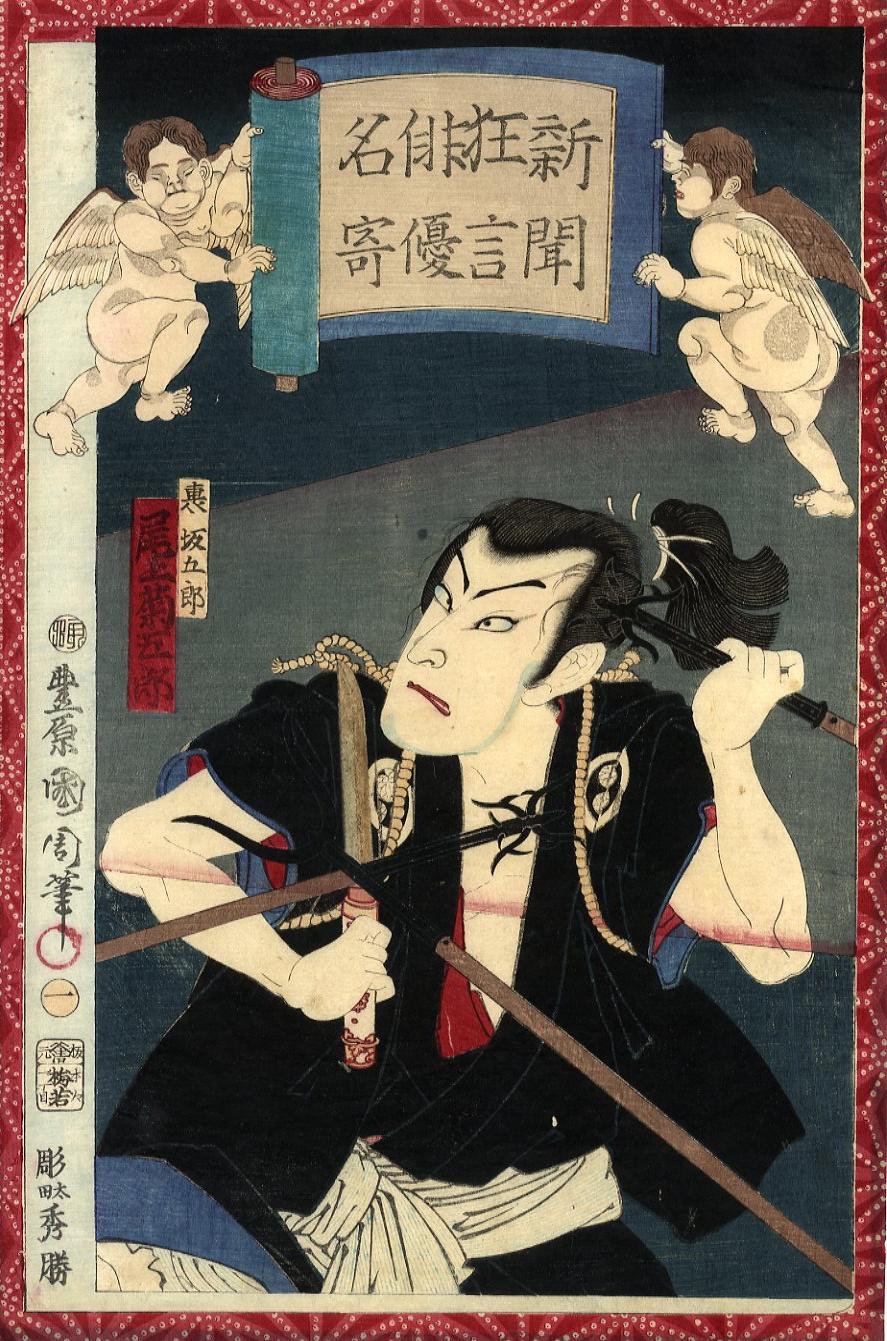|
Meiji 8-8 (1875-08) Todoroki Sakagorō by Onoe Kikugorō The woodblock print to the right is represented as the 1st in a series. Numerous kabuki prints produced in 1875 and 1876 featured title cartouches held by cherubs, but none were as bold and spectacular as this one, by Toyohara Kunichika (豊原国周 1835-1900). The title of the series -- "Shinbun kyōgen haiyū nayose" (新聞狂言俳優名寄) -- relates that the prints represent "news" (shinbun 新聞) about a lineup (nayose 名寄) of actors (haiyū 俳優) in kyōgen (狂言) works -- the shorter and usually comical interludes between the main features of a kabuki, bunraku, or nō stage. Todoroki Sakagorō is a character in "Hanamidoki yui makuhari" (花見時由井幕張), a kabuki and bunraku (jōruri) play by Kawatake Shinshichi II (河竹新七 1816-1893), who was born Yoshimura Yoshisaburō (吉村芳三郎) and retired as Kawatake Mokuami (河竹黙阿弥). The play was performed as a kabuki work in May 1875 at the Kawarazaki-za (河原崎座) theater in Tokyo, for which Kawatake was the main playwright. He wrote plays for particular actors, including Onoe Kikugorō V (五代目尾上菊五郎 1844-1903), who plays Todoroki Sakagorō in this performance. The print is one of many that were published at the time to supply the demand for souvenir prints celebrating the performance. Toyohara KunichikaThe designer of this print, when a young teenager named Arakawa Yasohachi (荒川八十八), first studied under Toyohara Chikunobu (豊原周信), apparently to learn to draw actors in the making of hagoita (羽子板), a battledore-like paddle that is highly decorated -- then with likenesses of actors or beauties. In 1848, Arakawa became a student of Kunisada when known as Toyokuni III (国貞, 三代豊国 1786-1865), and in 1855 he adopted Kunichika as his signature name, from the "kuni" and "chika" of the signature names of his two mentors. Toyohara Kunichika at times drew other kinds of prints but was known as "Yakusha no Kunichika" (役者絵の国周) for his actor prints. He also trained a few drawers who themselves designed mostly actor prints. HagoitaHagoita are used to bat shuttlecock-like feathered balls called hago or hane (羽子) back and forth between two or more players. The games is still played today, but most hagoita now feature images of popular singers, movie stars, athletes, and other public figures -- even politicians and foreign celebrities. European-style badminton, an Olympic competition in which several Japanese athletes have excelled, has made significant inroads into the New Years hagoita market. Kabuki picturesPrints featuring popular kabuki actors, playing particular characters in specific performances, ranked with landscape prints among the most popular woodblock publications. Fans bought prints of their favorite actors or performances, much like fans of popular singers, movie stars, and athletes today buy their cards, photobooks, and biographies. Not a few nishikie designers specialized in kabuki prints, which depicted popular actors playing particular roles in specific performances. Designers who worked mainly in other genres also at times accepted commissions to draw kabuki prints, but most prints were designed by drawers known for their adeptness at capturing actors in character. I don't collect, and have no personal interest in, kabuki prints as a genre. I bought this print only because of the spectacular cherubs pressed into the service of upholding the partly unrolled scroll. The cherubs are like those made popular by Ochiai Yoshiiku on the mastheads of his popular "Tōkyō nichinichi shinbun" nishikie series published by Gusokuya, the main run of which ended the same month as the print shown here published. For a look at this print as a "cherub" work, see Kabuki nishikie in the "Cherubs and banners" article in the "Articles" section. |
www.wetherall.org
